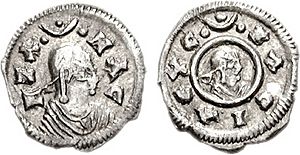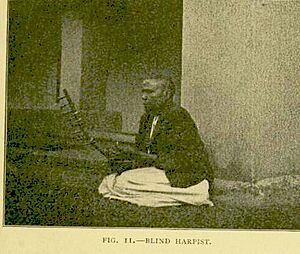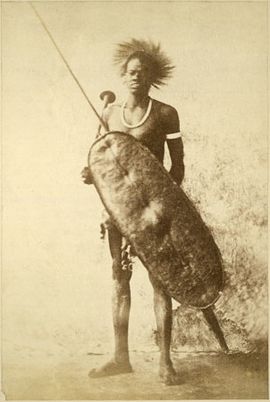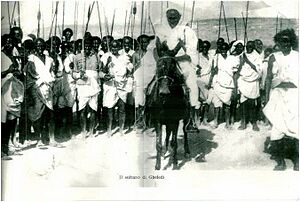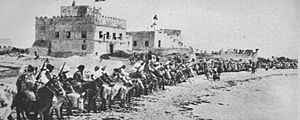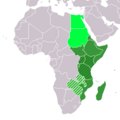History of East Africa facts for kids
East Africa is a huge region on the eastern side of Africa. It's bordered by North Africa, Central Africa, Southern Africa, the Indian Ocean, and the Sahara Desert. The history of East Africa is like a big story with many chapters. It includes ancient times, the rise of powerful kingdoms, the period when European countries took control, and finally, when modern nations were formed.
The borders you see between countries today were often drawn during the colonial period. These lines sometimes cut across different ethnic groups, meaning people from the same group might live in two different countries.
Contents
Geography and Climate of East Africa
East Africa has many different landscapes. South of the Sahara Desert, you'll find a dry, grassy area called the Sahel. This area is a transition zone between the desert and the greener Sudanian Savanna to the south. The savanna is a wide belt of tropical grasslands and shrublands that stretches across Africa.
Thousands of years ago, around 15,000 BC, the climate in Africa changed a lot. More rain caused the Sahara Desert to become green with lakes, wetlands, and savannas. This "Green Sahara" period lasted for a long time but ended between 5500 BC and 4000 BC.
Ancient Times: Early Humans and Iron Age Discoveries
Early Human History
East Africa is a very important place for understanding early human history. In Kenya, at a place called Panga ya Saidi, scientists found the burial of a young child from about 78,300 BC. This was during the Middle Stone Age.
Later, around 13,000 BC, people called Nubians lived in a tropical area called Jebel Sahaba. They looked similar to people living in other parts of Africa today. Between 8000 BC and 2000 BC, herders from the Sahara region moved into East Africa. They brought their traditions, including how they buried their dead.
The Iron Age Begins
The knowledge of how to work with iron, called archaeometallurgy, started in different parts of Africa, including East Africa. This means Africans developed these technologies themselves. The oldest signs of iron smelting in East Africa come from Nubia, dating back to the 7th and 6th centuries BC. In a city called Meroe, ancient furnaces produced metal tools for the Nubians and Kushites. They even made extra tools to trade!
There's also proof that a special kind of strong steel, called carbon steel, was made in Western Tanzania by the ancestors of the Haya people. This happened as early as 2,300 to 2,000 years ago (around 300 BC). They used a complex process to heat furnaces to very high temperatures.

Note: Dates are approximate. Check specific articles for more details. Iron Age
Ancient Kingdoms and Empires
The Bantu Expansion
Long ago, people who spoke Bantu languages started moving from West Africa to other parts of Sub-Saharan Africa. They brought their pottery styles with them. These pottery styles, like the Urewe type from Lake Victoria, spread across East Africa and even further south.
These Bantu-speaking farmers also created amazing white finger-painted rock art in places like Tanzania, Malawi, and Zimbabwe. This art showed concentric circles, stylized humans and animals, and even crocodiles and snakes. Crocodiles were linked to rainmaking and fertility. This rock art was likely used for special ceremonies, like initiation rites for young people.
Kingdom of Kush
The Kerma culture was a powerful kingdom in southern Nubia, in what is now Sudan. It grew to be as large as Egypt! The Egyptians were the first to call this kingdom "Kush." For centuries, Egypt and Kush traded, exchanged cultures, and sometimes even fought. Kush was the earliest known kingdom in Sub-Saharan Africa, lasting from 2500 BC to 1500 BC.
Kingdom of Punt
The Land of Punt was a mysterious place that ancient Egyptians visited. The earliest recorded Egyptian trip to Punt was around 2500 BC. They brought back valuable goods like gold and special resins. More expeditions followed over many centuries, showing how important trade with Punt was to Egypt.
Aksumite Empire
The Kingdom of Aksum was a powerful empire in what is now Ethiopia and Eritrea. Some historians believe it started as a colony of the Sabaeans from the Arabian Peninsula. Others think it developed mostly on its own, with only a small Sabaean influence. Aksum became very important for trade and later adopted Christianity.
The Swahili Coast
Before the Swahili period, people living along the East African coast were farmers, fishers, and herders. They did well because of good rainfall and rich seafood from the shallow coast. Trade became very important starting in the early 1st millennium CE. Natural harbors and yearly monsoon winds helped ships travel easily.
Later, many Bantu-speaking people moved to the coast. The communities there shared similar ways of life with people living further inland, as shown by archaeological finds like pottery.
Medieval Kingdoms and Sultanates
Harla Kingdom
The Harla Kingdom was a state in eastern Ethiopia around the 6th century CE. It traded with powerful dynasties like the Ayyubids and Tang. It even had its own money and calendar!
Kingdom of Bazin and other Beja Kingdoms
The Kingdom of Bazin was an early medieval kingdom in Northeast Africa. It was one of six Beja kingdoms in the region during the 9th century CE. Its territory stretched between Aswan and Massawa. Other similar Beja kingdoms included Belgin, Jarin, Qita'a, Nagash, and Tankish.
Kingdom of Semien
The Kingdom of Aksum began to convert to Christianity around the time of Emperor Ezana of Axum. This conversion started at the royal court and along trade routes. Later stories tell of a revolt by Jewish people, but there's no direct proof for this. It's possible that Christian rulers sent opponents to the Simien Mountains, which later became a stronghold for the Beta Israel (Ethiopian Jewish) community.
Tunni Sultanate
The Tunni people established their own Sultanate in Qoryoley. They made a treaty with the Jiddu people to share land and resist outsiders. However, they welcomed early Muslim migrants from Yemen and Syria around the 10th century CE for religious and trade reasons. Barawa became the new capital and a major Islamic center, attracting scholars from all over.
The Tunni people eventually became farmers, growing fruits and vegetables in the fertile Shebelle valley. They also traded food with coastal towns.
Sultanate of Showa
The Sultanate of Showa was a Muslim kingdom in present-day Ethiopia. Its capital was Walale. This kingdom's rise may have led to the decline of the Kingdom of Aksum. Engravings from the 13th century CE show the kingdom's presence in various locations.
Kilwa Sultanate
The story of the Kilwa Sultanate began around 960 CE – 1000 CE. This sultanate became a powerful trading state along the Swahili Coast.
Ethiopian Empire
The Ethiopian Empire began around 1270 CE with the establishment of the Solomonic dynasty. This empire would become one of the longest-lasting in Africa.
Sultanate of Ifat
The Sultanate of Ifat emerged when Umar ibn Dunya-huz, also known as Sultan Umar Walasma, created his own kingdom. He conquered the Sultanate of Showa. His actions were similar to how Emperor Yekuno Amlak of Ethiopia was uniting Christian territories at the same time.
Sultanate of Mogadishu
For many years, Mogadishu was the most important city on the Somali coast. A Syrian historian in the 12th century CE described it as the richest and most powerful city in the region, and an important Islamic center. In the early 13th century CE, Mogadishu became part of the Ajuran Sultanate and entered a "Golden Age" of prosperity.
Kingdom of Buganda
Originally, Buganda was a smaller state under the control of Bunyoro. But in the 18th and 19th centuries CE, Buganda grew very powerful. It expanded its control around Lake Victoria using war canoes. The kingdom was well-organized when British explorers first arrived in 1862 CE.
Ajuran Sultanate
The Ajuran Sultanate was a Somali empire in medieval times. It controlled trade in the northern Indian Ocean. The Ajuran Empire had a strong government and military. They successfully fought off invasions from the Oromo people and the Portuguese. Trade routes from ancient times were strengthened, and ships sailed to and from many kingdoms in Asia and Europe.
Kingdom of Kaffa
The Kingdom of Kaffa was founded around 1390 CE by a leader named Minjo. Oral traditions say he took power from an older dynasty.
Kingdom of Rwanda
Before the 19th century CE, the Tutsis were often military leaders, while the Hutus were known for healing and farming. However, over time, the kings of Rwanda centralized their power. They started giving land to individuals instead of family groups, and many of the new chiefs they appointed were Tutsi. This system, especially after 1860 CE, meant Hutus often had to work for Tutsi chiefs in exchange for living on their land.
Adal Sultanate
The Adal Sultanate was centered around Zeila, its capital. It was founded by local Somali tribes in the early 9th century CE. Zeila became a busy trading city, attracting merchants from all over the world. It was also one of the first cities in the world to embrace Islam.
Shilluk Kingdom
According to legends, the Shilluk Kingdom was founded in 1490 CE by a hero named Nyikang. He was said to be half-crocodile and could control the rain! Nyikang led his people on a journey, eventually settling in the area near present-day Malakal.
Ankole Kingdom
The Banyankore people trace their history back to the Bairu and Bahima groups. The Ankole Kingdom was officially ended in 1967 CE by the Ugandan government.
Modern History: New Powers and Colonialism
Sennar Sultanate
The Christian kingdoms of Nubia began to decline around the 12th century CE. By the 15th century CE, Bedouin tribes had taken over much of Sudan. In the early 16th century CE, the Funj people defeated a tribal federation and founded the Sennar Sultanate in 1504 CE.
Kingdom of Burundi
The exact founding date of the Kingdom of Burundi is unknown, but it likely began in the 17th century CE. During this time, the Tutsi ethnic group gained power over the larger Hutu population. Under King Ntare I (1675 CE – 1705 CE), the kingdom expanded. Even though it had a king, local rulers had a lot of independence.
Sultanate of the Geledi
By the end of the 17th century CE, the Ajuran Sultanate was weakening. Various smaller groups broke away. One of these was the Silcis Sultanate. Ibrahim Adeer led a revolt against the Silcis ruler. After his victory, Ibrahim declared himself Sultan and started the Gobroon Dynasty.
The Geledi Sultanate became a powerful Rahanweyn kingdom. It controlled the entire Jubba River region and was very active in trade.
Sultanate of Aussa
In 1734 CE, the Afar leader Data Kadafo took power and started the Mudayto Dynasty. This marked the beginning of a more organized state that lasted into the colonial period. The Sultan's main symbol was a silver baton, believed to have magical powers.
Majeerteen Sultanate
The Majeerteen Sultanate was founded around the 1600s CE by Somalis from the Majeerteen clan. It became very important in the 19th century CE under the rule of King Osman Mahamuud.
Isaaq Sultanate
The modern Guleed dynasty of the Isaaq Sultanate was established in the mid-18th century CE. Sultan Guled was crowned after his father, a religious leader, led the Isaaq to victory in a battle. Guled ruled until 1839 CE.
Habr Yunis Sultanate
The Habr Yunis Sultanate was a Somali kingdom that ruled parts of the Horn of Africa during the 18th century CE. It covered the territories of the Habr Yunis clan in modern-day Somaliland and Ethiopia.
Tooro Kingdom
The Tooro Kingdom broke away from the Bunyoro kingdom before the 19th century CE. It was founded in 1830 CE when Prince Kaboyo Olimi I, the eldest son of the Bunyoro king, left and created his own independent kingdom.
Sultanate of Hobyo
Initially, Ali Yusuf Kenadid wanted to take control of the nearby Majeerteen Sultanate. He failed and went into exile in Yemen. In the 1870s CE, Kenadid returned with a group of supporters and established the Sultanate of Hobyo in 1878.
In the late 1880s CE, Sultan Kenadid signed a treaty with the Italians, making his kingdom an Italian protectorate. He hoped to use Italy's support to expand his territory and keep his kingdom independent from other European powers.
Kingdom of Karagwe
The Karagwe kingdom was one of the many Great Lakes Kingdoms in East Africa. It reached its peak in the 19th century CE, especially under King Ndagara, who ruled from around 1820 CE to 1853 CE.
Kingdom of Urambo
Much of King Mirambo's success in the Kingdom of Urambo came from his connections with the Watuta, a sub-group of the Ngoni people. Mirambo learned about their military systems and created his own similar army called the rugaruga, which had about 10,000 members by the early 1880s CE.
Slave Trade in East Africa
East Africa was involved in various slave trades, including the Trans-Saharan slave trade, Indian Ocean slave trade, and Red Sea slave trade. These trades had a significant impact on the region's history and people.
Colonial Period
The Scramble for Africa in the late 19th century CE saw European powers divide up the continent. This led to the Colonisation of Africa, where countries like Portugal and Britain established control over different parts of East Africa.
Post-Colonial Period
After World War II, many African nations began to gain their independence in a process called Decolonisation of Africa. This led to the formation of the current nations in East Africa, each with its own challenges and opportunities.
Images for kids
-
Map of Eastern Africa:
Green: Eastern Africa (UN Subregion)
Dark Green: East African Community
Very Light Green: Central African Federation (Political: Defunct)
Light Green: Geographic, including above -
Satellite imagery of East Africa.



